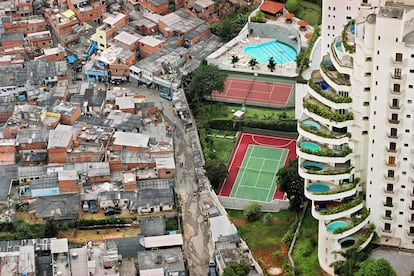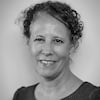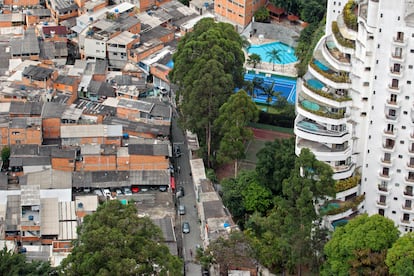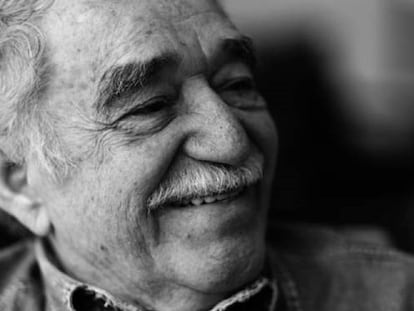Nearly 20 years on since famous snapshot of inequality in Brazil, little has changed
Almost two decades have passed since the striking image shone a light on the divide between the rich and the poor. EL PAÍS speaks to its photographer about why such scenes are still common in the country


Eighteen years have passed since Brazilian photojournalist Tuca Vieria climbed aboard a helicopter to photograph São Paulo from the air as part of a long feature report. During that flight, he took the picture that would become a global emblem of inequality and one of the most famous portraits of the abyss between the rich and the poor in the world. The contrast between the balconies with swimming pools and lush tennis courts below with the rundown houses of a favela appeared to be the work of Photoshop. But this wasn’t the case. It was a reflection of the divide between those who have it all (and continue to amass wealth) and those who have nothing.
The photo, published hundreds of times online and in print, traveled around the world. Now, just as a group of millionaires and billionaires intervened in the World Economic Forum in Davos to say they wanted to pay more taxes, it has been 18 years since the snapshot of inequality made the front page of the Brazilian daily Folha de S.Paulo. Inequality is also in the headlines today after a report by Oxfam showed that the 10 richest men in the world doubled their wealth during the coronavirus pandemic.
The photo only reached the scale that it has today when it got overseas
But let’s return to the photo. “I was doing a report for the 450th anniversary of São Paulo, which was going to go in a little booklet,” says Vieira, 47, by phone, explaining that he wanted to provide a “dose of reality” to all the stories of the city’s most-celebrated moments. His editors liked the photo so much they published it on the front page and inside the paper. Part of the success of the image, which changed his career, was due to his colleague Marlene Bergamo. It was she who suggested that he take an aerial view of the border between the Paraisópolis favela and the Penthouse tower in Morumbí neighborhood, an area of São Paulo he didn’t know.
The photograph can be read in two ways: from a Brazilian and foreign perspective, he explains. In Brazil, it made an impact, but according to Vieira “it only reached the scale that it has today when it got overseas.” When it was published in Europe, it took on a new life, even becoming something of a phenomenon. Last year, Vieria took another photo of the area from the same perspective. Little has changed. The divide appears clearer. The most visible changes are the trees to cover the site of the favela. It’s the same reality, one that is usually represented in numbers.


In Brazil, there is a real obsession with quantifying everything. That’s why there is a constant stream of figures on the vertiginous level of social-economic inequality in the country. Amid the avalanche of recent numbers, two data points stand out for their gut-wrenching scale.
One refers to São Paulo: the residents of the worst neighborhood in the city live 23 years fewer than those of the best. It’s as though one city – the wealthiest in Latin America – contained the realities of both Morocco and Denmark. The average life expectancy for locals of the Cidade Tiradentes neighborhood is 58.3 years, while in Alto de Pinheiros, it’s 80.9, according to the 2021 inequality map released by the NGO Rede Nossa São Paulo. The two neighborhoods are separated by a socioeconomic abyss and 50 kilometers, a distance that can be covered in public transportation, albeit in a journey that takes 2.5 hours and requires four transfers. It’s a trip thousands of nannies and doormen make every day.
The second data point is about Brazil. The wealthiest 1% of white men in the country have more income than all Black and mestizo women put together. In other words, 700,000 men hold 15% of national income, while these women – who are the largest demographic group in Brazil – have just 14.3%, according to a study by the University of São Paulo.
Brazil has become Belindia, a term made up in the 1970s by economist Edmar Lisboa Bacha, to describe a fictitious country made up of Belgium and India, with the laws and taxes of a small rich state, and the social reality of a large, poor nation. Brazil is much richer than it was half a century ago, but this wealth remains in the hands of the minority.
Since Rede Nossa São Paulo made the first map of inequality a decade ago, little has changed. The coordinator of the NGO, Jorge Abrahõ, explains that there “have been small improvements and setbacks, but generally it is stalled.” He adds: “What is really striking is that Brazil is able to generate wealth, but not distribute it.”
The socio-economic divide narrowed slightly under the Working Party governments of Luiz Inácio “Lula” da Silva in the early 2000s. But Brazil remains one of the most unequal countries in the world. The share of wealth was also disproportional in these years. The problem comes down to the power structure, to who is making the laws, says Abrahõ. “It’s a structural part of how Brazil is organized. Governments, even well-intentioned ones, cannot involve themselves with these structures that perpetuate inequality,” he says.
According to Abrahõ, São Paulo is a reflection of Brazil, with some nuances given the vastness and diversity of the country. Brazil is the same size as the European Union, and has a population of 210 million people who are descendants of slaves, white immigrants and indigenous people.
The contrasts are evident to anyone in São Paulo, an urban hub of 12 million people. And they are quantified in the inequality maps. Amid the sea of data, some figures are truly shocking. With respect to the number of teenage pregnancies, the worst neighborhood in the city has a figure that is 60 times higher than in the best. School dropout rates are 70 times higher, the waiting period for a basic medical checkup is 12 times longer and the mortality rate for Covid-19 twice as high. In one-third of the city’s districts, there is not a single train, Metro or tram in a kilometer radius – only the bus comes in.
Collective memory
Vieria points out that his striking photo “has symbolic power, which says a lot about our collective memory, beyond the documentative power.” Because in reality, the overblown Penthouse tower is considered tacky. While Paraisópolis, which expanded until it was touching the bottom of the skyscraper, is one of the most dynamic favelas in Brazil, despite its many shortcomings.
Anyone in Brazil knows that the rich – the wealthiest 1% – don’t live in buildings like the Penthouse tower. Instead, they escape to their bubbles: urban developments of luxury chalets and rolling green grass, where walls and security controls keep people away from its small and quiet streets. This part of Brazilian society, unable to travel abroad due to the pandemic, has given a boost to the local luxury sector. Porsche sales are at record highs and the waiting list to buy a helicopter is now 20 months.
But anyone on the street can see how homelessness has grown during the pandemic. Families with children have joined the tens of thousands of people living on the street due to poverty and addiction. According to the latest official count, before the pandemic, 24,000 people were homeless – more than the population of some districts. Some NGOs believe this number has now tripled to 66,000. For Vieria, this is an image no one should get used to.
Tu suscripción se está usando en otro dispositivo
¿Quieres añadir otro usuario a tu suscripción?
Si continúas leyendo en este dispositivo, no se podrá leer en el otro.
FlechaTu suscripción se está usando en otro dispositivo y solo puedes acceder a EL PAÍS desde un dispositivo a la vez.
Si quieres compartir tu cuenta, cambia tu suscripción a la modalidad Premium, así podrás añadir otro usuario. Cada uno accederá con su propia cuenta de email, lo que os permitirá personalizar vuestra experiencia en EL PAÍS.
¿Tienes una suscripción de empresa? Accede aquí para contratar más cuentas.
En el caso de no saber quién está usando tu cuenta, te recomendamos cambiar tu contraseña aquí.
Si decides continuar compartiendo tu cuenta, este mensaje se mostrará en tu dispositivo y en el de la otra persona que está usando tu cuenta de forma indefinida, afectando a tu experiencia de lectura. Puedes consultar aquí los términos y condiciones de la suscripción digital.
More information
Archived In
Últimas noticias
Most viewed
- Sinaloa Cartel war is taking its toll on Los Chapitos
- Oona Chaplin: ‘I told James Cameron that I was living in a treehouse and starting a permaculture project with a friend’
- Reinhard Genzel, Nobel laureate in physics: ‘One-minute videos will never give you the truth’
- Why the price of coffee has skyrocketed: from Brazilian plantations to specialty coffee houses
- Silver prices are going crazy: This is what’s fueling the rally










































